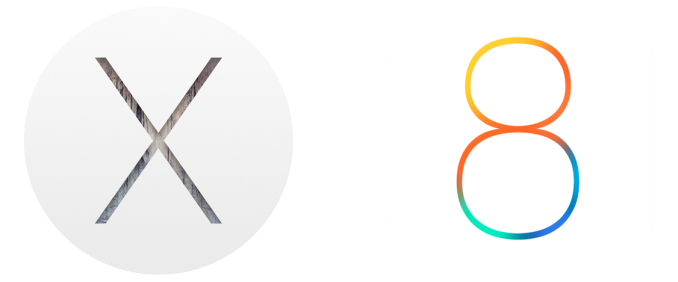A Look At OS X Yosemite And iOS 8.1
by Brandon Chester on October 27, 2014 8:00 AM EST
Introduction
It has been a busy year for Apple, although one could argue it has been more of a busy few months. The yearly updates for most of Apple's products now occur in September and October, and as a result we've seen the release of a number of new products and services in a very short period of time. On the hardware side we have the new iPhone 6 and 6 Plus, the iPad Air 2 and Mini 3, the iMac with Retina 5K display, and a preview of the upcoming Apple Watch. The software side has arguably been even more exciting with the release of iOS 8 and its first major update iOS 8.1, OS X Yosemite, and Apple Pay.
The theme this year appears to be integration and the power of a software and hardware ecosystem. Apple has always had some level of integration between iOS and OS X. As time went on, both operating systems began to share a core set of applications like Reminders, Calendar, and Notes. The iPad extended this even further by bringing the iWork and iLife suites to mobile. iCloud also played a key role in integrating both systems, by synchronizing documents and photos between all of a user's devices. However, the launch of iOS 7 with its visual and functional enhancements left many of the shared features and applications on OS X feeling left behind.
OS X Yosemite brings with it a massive visual overhaul, on a scale even greater than what we saw with iOS 7. This makes sense, as OS X is an operating system for desktops and laptops which makes it inherently more expansive and complex than iOS. Although OS X is not nearly as popular as iOS in terms of user base, the fact that the redesign changes some visual elements that have existed for over 14 years makes it quite a monumental moment in Apple's history. These changes finally unify the visual styles of both operating systems, which were once united but split with the launch of iOS 7.
The integration of these two operating systems goes far beyond a common type of visual design. OS X Yosemite and iOS 8.1 also include new features that allow them to work together in unprecedented ways. Features like Handoff blur the borders between the iPhone, the Mac, and the iPad by allowing you to continue work you began on one device on another. SMS and call forwarding takes communication abilities that were typically reserved for the iPhone and brings them to every device.
There's a lot to talk about, and it all begins at the aesthetic level with the new design of Yosemite.










173 Comments
View All Comments
Anandrian - Monday, October 27, 2014 - link
maybe quicksilver was his choice :D. Quicksilver is an awesome launcher but I stopped using it after Yosemite was released. I never used the power features of Quicksilver.solipsism - Monday, October 27, 2014 - link
Before it was in the upper-right corner. Even if you pressed ⌘-Space Bar it was still a tiny text field. The current design pulls from 3rd-party launchers to integrate a lot more services that are now possible with it being in the center of the screen and very large.My guess is he probably had apps in the Dock that were always running like most Mac users.
Brandon Chester - Monday, October 27, 2014 - link
I have my most often used apps in the Dock and I also use launchpad and Finder when I happen to be in it.slatanek - Monday, October 27, 2014 - link
I'd say the Yosemite thing is... like a live beta. I've updated my girlfrined's MBP retina (late 2013) and everything feels just more laggy and a lot of things just lack polish and looks kinda meh. The login screen sometimes presents itself as it suppossed to do and sometimes it's just a blank page , totally random. I still can login but the password you type in is not visible as the background isn't. The way the search field in spolight comes on in the middle of the screen - horrible looking and annoying.The rest of it is just the same as usual - not bad, not particularly good either. Finder still stays lightyears behind windows explorer. Copying/moving/deleting stuff in OSX is still a pain. Also when you go with finder full screen there is a visual bug as well the open enlarge dots get strangely squashed under the top bar as it comes down when highlighted. I wonder when will they drop the file system overall ;-)
Messy Apple, this time it's messy...
bwanaaa - Monday, October 27, 2014 - link
HackerNews had an interesting ref about the new 'insecurity model'. All your stuff that you are working on (email drafts, unsaved textedit docs, etc) is now stored in iCloud (silently).xxsk8er101xx - Monday, October 27, 2014 - link
No it doesn't. You can choose to not do that. It's not done as a conspiracy it's done to improve the user experience.Take the tin foil hat off!
sjprg2 - Monday, October 27, 2014 - link
No! the Icloud is to retrain the newcomers to the process of the mainframe mentality with all software eventually on the Icloud(mainframe) with remote administrators. With hardware locked down (soldered in) we are now back in the 1960s. With no local abilities we only get what the manufacturers want to give us at their price. IBM's apps used to cost 10-20 thousand each.name99 - Monday, October 27, 2014 - link
Oh for crying out loud...Grow up. The Matrix is NOT a documentary, you know.
Slaanesh - Monday, October 27, 2014 - link
Translucency was already in Vista, right?And is that a gadget sidebar in the screenshot on p2?
blackcrayon - Monday, October 27, 2014 - link
Translucency was in Mac OS X 10.0 in 2001.